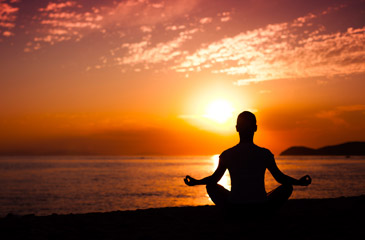Developing Still and Alert Attention

Photo: Thinkstock
Set aside a certain amount of time when you can be alone and undisturbed. Five to 10 minutes is a good amount of time for those who are just beginning meditation practice; eventually you may settle on 20 or 30 minutes. Sit on a chair or cross-legged on the floor, and feel a sense of balance and alertness in your posture. Rest your hands on your thighs or knees, and close your eyes. Now, bring your attention to your breath. Take a deep inhalation and release it with a sigh. Relax your shoulders, your jaw, and your belly. Release anything you are holding on to and give yourself permission to take these few minutes for yourself.
Staying alert yet relaxed, bring your attention to your breathing. Observe your natural inhalations and exhalations. Witness each in-breath as it enters your body and fills it with energy. Witness each out-breath as it leaves your body and dissipates into space. Then start again, bringing your alertness to each breath.
In less than one minute your mind will probably be flooded with thoughts. You may become aware of pain in your body. Perhaps you will feel restless, anxious, or bored. You will begin to tell yourself stories about your thoughts, feelings, and sensations.
Congratulations! You are meditating. The purpose of meditation is to become aware of your thoughts without judging or fighting them. Your goal is not to get rid of your thoughts, but rather to witness each thought as it comes and goes, like clouds passing in the sky. In this way, you begin to identify less with your thoughts—the "voice in your head"—and more with the still and alert Presence that is your essence.
Staying alert yet relaxed, bring your attention to your breathing. Observe your natural inhalations and exhalations. Witness each in-breath as it enters your body and fills it with energy. Witness each out-breath as it leaves your body and dissipates into space. Then start again, bringing your alertness to each breath.
In less than one minute your mind will probably be flooded with thoughts. You may become aware of pain in your body. Perhaps you will feel restless, anxious, or bored. You will begin to tell yourself stories about your thoughts, feelings, and sensations.
Congratulations! You are meditating. The purpose of meditation is to become aware of your thoughts without judging or fighting them. Your goal is not to get rid of your thoughts, but rather to witness each thought as it comes and goes, like clouds passing in the sky. In this way, you begin to identify less with your thoughts—the "voice in your head"—and more with the still and alert Presence that is your essence.
Adapted from The Seeker's Guide. Copyright © 2000 by Elizabeth Lesser. Excerpted by permission of Villard, a member of Random House Publishing Group. All rights reserved. No part of this excerpt may be reproduced or reprinted without permission in writing from the publisher.



